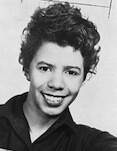
Acclaimed playwright Lorraine Hansberry was recognized recently on her 81st birthday had she still been alive. Hansberry was well known during the 1950s and 1960s in New York and throughout the country., a photo by Pan-African News Wire File Photos on Flickr.
Lorraine Hansberry – Young, Gifted and Black
5/19/2011
Born 81 years ago today, playwright and author Lorraine Hansberry is best known for A Raisin in the Sun. Today we celebrate her life and work.
Lorraine Hansberry was born in Chicago in 1930, the youngest of four children in a prominent black family. Her father was a successful real estate broker and active member of the local Republican party, even running for Congress in 1940. African-American leaders and intellectuals were frequent guests in the Hansberry house, including W.E.B. DuBois, Langston Hughes, Jesse Owens and Duke Ellington.
In an incident that would loosely inspire Hansberry’s most famous work, when she was eight years old the family was attacked by a racist mob after moving into a white Washington Park neighborhood on Chicago’s South Side. Hansberry’s father would take the resulting civil rights case all the way to the Illinois Supreme Court. One of her brothers also refused to be inducted into the Army during WWII, citing its segregation policy.
Despite their relative wealth, the family insisted on sending their children to public schools in order to help fight segregation. A pivotal experience in young Hansberry’s life was seeing a school production of the Sean O’Casey play Juno and the Paycock, which she credits with making her want to be a writer.
Hansberry briefly studied art at the University of Wisconsin-Madison before dropping out and moving to New York City. There, she attended The New School for Social Research (whose students during roughly the same period included Harry Belafonte, Marlon Brando and Jack Kerouac). She worked as an editor of Paul Robeson’s radical Freedom journal. To help support herself, she also worked as a waitress and a cashier.
In 1953, Hansberry married student and songwriter Robert Nemiroff, whom she met on a picket line protesting the exclusion of black athletes from collegiate athletic teams. Nemiroff’s songwriting success with hit song “Oh Cindy, Oh Cindy” would allow Hansberry to turn to writing full time.
The result was 1959’s A Raisin in the Sun, the first play by an African American to debut on Broadway and one which, according to the New York Times, “changed American Theatre forever.”
The kitchen sink drama was considered a risky financial investment – not least of all because it featured an all African-American cast (including Sidney Poitier, Ruby Dee and Louis Gossett, Jr.). It took over a year to raise enough money to debut the play and early reviews were mixed.
But after positive off-Broadway runs in New Haven, Chicago and Philadelphia, the play began to gather steam. Making its Broadway debut at the Ethel Barrymore Theatre, it introduced white audiences to scenes of black life they’d never seen before and drew black audiences to Broadway like no show before.
A Raisin in the Sun would be nominated for four Tony Awards and run for two years, while Lorraine Hansberry became the youngest American to receive the New York Drama Critics' award for the best play of the year. The work was later adapted into a 1961 film.
Her first play would, unfortunately, prove her only unqualified success. Following its glowing reception, Hansberry was hired by NBC to write a slavery drama for TV but the result, The Drinking Gourd, was never aired as execs felt it was too violent and politically controversial (the teleplay was a collaboration with her husband Nemiroff, but by 1964 they had amicably divorced). Her next play, What Use Are Flowers, made few ripples. While she continued writing plays, she also penned essays and helped produce works for the Student Nonviolent Coordinating Committee. Hansberry joined the country’s first lesbian political organization, The Daughters of Bilitis, and frequently spoke out about homophobia.
Hansberry also had to deal with the unwanted attention Raisin’s success brought to her family in Chicago. Controversially accused of being slumlords, the family eventually relocated to Los Angeles to escape the stigma.
Meanwhile, Hansberry’s health was rapidly deteriorating. She battled pancreatic cancer and was in and out of hospitals during much of her final years, often arriving in a wheelchair to rehearsals for her final play, The Sign in Sidney Brustein’s Window. The play closed its successful run on the eve of Hansberry’s death on January 12, 1965. She was only thirty-four years old.
More than 50 years after its debut, A Raisin in the Sun remains a vital piece of American drama, living on in all manner of adaptations from high school productions to feature Hollywood movies like the 2008 version starring Sean “Puffy” Combs and Phylicia Rashad. Its continued relevance fulfills the words Martin Luther King, Jr. wrote for her funeral:
“Her creative ability and her profound grasp of the deep social issues confronting the world today will remain an inspiration to generations yet unborn.”
No comments:
Post a Comment